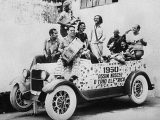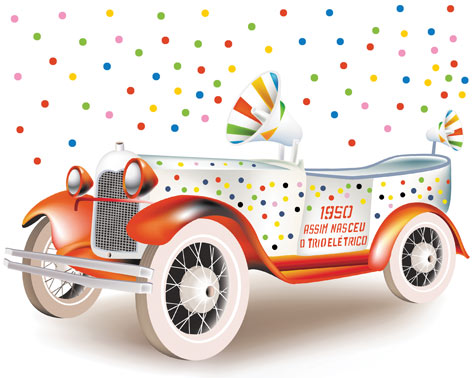Este post também está disponível em:
Português
English

The electric trio of musicians Dodô and Osmar celebrated 64 years of existence in 2015, while axé turns 30. Without this sound truck, the Bahian Carnival would definitely not be the same.
But those who frequent the circuits of the Bahian festival and are impressed by the structure of the mobile stages cannot even imagine that in the beginning the trios were nothing more than a car with an amplifier connected to the battery.
And it wasn’t a trio. It was a duo. And what a duo: the musicians Dodô and Osmar (after whom Salvador’s parade circuits are named) were the creators of this concept.
It all started in 1951, when the Recife club Vassourinhas invited the two musicians to play at the Salvador Carnival in a 1929 Ford that was restored for the performance. The success among the public was enormous.
The following year, they called the musician Temístocles Aragão to participate in the Carnival. It was with this formation that they began to be called Trio Elétrico.
The name caught on and other bands that played in open cars began to receive the same name. Armandinho, Osmar’s son, recalls that, as time went by, the vehicles that carried the musicians grew in size to keep up with the growth of the bands that took part in the party.
The soteropolitans Adolfo Nascimento (“Dodô” – 10/11/20) and Osmar Alvares Macêdo (22/03/23) were responsible for one of the most fertile chapters in the history of northeastern and even world roots music.
They managed to electrify the Pernambuco frevo and created a new way of bringing music to the revelers of the Salvador carnival and then all over Brazil.

The duo were at the cutting edge of technological development added to music, as they created, in the year ’42, an electric guitar, “the Bahian guitar”, a year after the American Les Paul had built his first prototype electric guitar.
The “electric duo” also elevated frevo to an instrumental level never imagined by Pernambucans.
Dodô & Osmar set new standards for the rhythm and would later come to incorporate other Northeastern and other musical genres into the “carnavalizing” revelry of the Trio Elétrico that changed the face of carnival in Bahia and then throughout the country.
Watch the video “History and evolution of the Trio Elétrico”

História e evolução do Trio Elétrico
On January 29, 1951, the Monday before Carnival, Dodô and Osmar had another key experience when they witnessed the parade of the Clube Carnavalesco Misto Vassourinhas do Recife, which was making a stop in Salvador on its way to Rio.
Vassourinhas specialized in frevo, a Pernambucan musical style in marching rhythm, known in Rio de Janeiro’s carnival since the 1930s.
The event, blessed by the authorities and supported by sponsors, radio stations and the city’s Pernambucan community, brought together an unprecedented number of people in downtown Salvador.
The following events were of great historical importance for the Bahian carnival: Osmar’s old Ford ’29, nicknamed Fobica, normally used to transport metal parts, was transformed into a movable stage, to allow the duo to perform Pernambuco frevo classics with their exotic electric sticks at high volume during the festivities.
Equipped with a 2 kilowatt generator, decorated with carnival motifs and speakers mounted on the front and rear, the musical Ford, came on stage on Carnival Sunday at around four in the afternoon.
Accompanied by six percussionists, including Armando Mereilles, Osmar’s father-in-law, dressed as a Hawaiian ‘ula ula’, the Fobica entered Chile Street at the Plaza Castro Alves, joining the car corso of the official parade.
This was the first time that Bahia’s popular carnival had openly conquered a space in the official part of the festival that, although public, was reserved exclusively for the activities of the elites.
It seems that the Vassourinhas parade, five days earlier, with those frevos received with such enthusiasm by the population, had served as a kind of rehearsal for the debut of the Dupla Elétrica and their Fobica.
The episode, which had left everyone – Dodô and Osmar included – slack-jawed, marked the birth of a new musical genre (today called frevo do trio, frevo novo, frevo baiano, etc.) and, at the same time, of a new way of playing carnival in Bahia, which would later be known as Trio Elétrico.
The following year, Dodô and Osmar replaced the Fobica with a Chrysler Fargo pickup and changed the formation from duo to trio, adding a triolin, also electrified in the manner of electric sticks, played by their friend Temístocles Aragão. Consequently, they also changed their name from Dupla Elétrica to Trio Elétrico.
Another year later, they already had a truck with eight speakers, flourescent lights and generators, sponsored by the local soft drink manufacturer Fratelli Vita (now Brahma). In the mid-1950s, when other bands began to copy the concept, the term Trio Elétrico became generic.
The following decades brought a tide of vans and trucks, transformed into mobile stages, ever increasing in size, sound system, and sophistication in the details of their decoration.
When Dodô and Osmar stopped parading in 1960, the phenomenon was already consolidated, and continued to grow in the hands of other trios such as Tapajós, organized by Orlando Campos from the second half of the 50s.
Today, almost 60 years later, the descendants of the old Ford 29 have evolved into brontosaurus-sized trucks, carrying equipment with outputs of up to 200 db(!), loudspeakers on all four sides, bands of up to 25 members plus dancers in their teitos shaking the crowds dancing around them, and scientific papers published on the effects of long-term exposure to their sound.
The fame of the trio elétrico even surpassed that of the Bahian guitar by a long way.
History and evolution of the Trio Elétrico in Salvador da Bahia



















